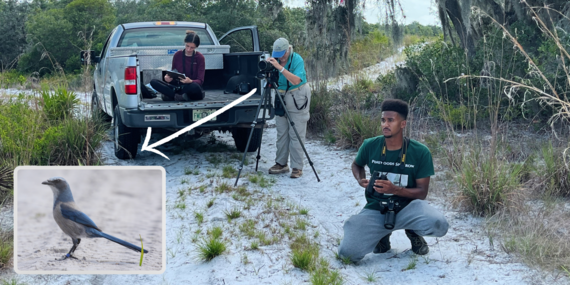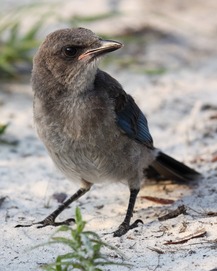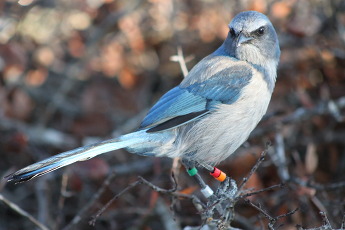 Virginia Tech is conducting group interviews to advance inclusion in wildlife viewing.
Do you observe, feed, or photograph wildlife? Do you identify as disabled and/or neurodiverse? We want to hear about your experience wildlife viewing and attending programs! We invite you to be part of a 90-minute online group discussion to share your experiences with wildlife viewing, and your thoughts on increasing inclusion. These discussions are part of a research project led by Virginia Tech, and participants will be provided with a $50 honorarium. This will help inform the work of state fish and wildlife agencies nationwide, and be part of a graduate student’s dissertation.
You are eligible to participate if you are:
- At least 18 years old;
- Live in the United States;
- Observe, feed, or photograph wildlife; and
- Identify as disabled and/or neurodiverse.
These 90-minute virtual focus groups will take place starting in June. You can select a time that works for you. If you choose to participate, what you share in your discussion will not be linked to your identity. As a thank you, all participants will receive a gift card honorarium, which will be prorated based on participation, starting at a base rate of $20 and increasing by $10 for each half hour up to a maximum of $50 for 1.5 hours.
If you are interested in joining a 90-minute online group discussion, please follow the link below or email wildlifeviewing@vt.edu for more information.
Link: https://tinyurl.com/WildlifeViewing
 Jay Watch volunteers in the field.
Florida Scrub-jays live exclusively in Florida’s native scrub habitat, a unique environment of ancient sandy ridges and dunes covered in evergreen shrubs, small trees and pines. However, there aren’t as many scrub-jays as there used to be. Much of their habitat has been lost to development, agriculture and fire exclusion since the 1800s, and the species is considered Federally Threatened. Protecting Florida Scrub-jays is a team effort, requiring hard work and coordination between conservationists, state agencies, land managers, birders and many others. One way this happens is through Jay Watch, a statewide community science program coordinated by Audubon Florida. To learn more about the project, the Great Florida Birding and Wildlife Trail spoke with Paul Jacobs, a Volunteer Program Biologist with the Florida Fish and Wildlife Conservation Commission who manages Jay Watch Volunteers.
What is the role of volunteers in Jay Watch?
Volunteers map the territory of individual Scrub-jay families. Surveys are done from predetermined points to determine the boundaries of different family groups. At some points you will see just one family, and at others you will see multiple families because you’ll be right on the line between their territories. By doing these surveys over time we can establish where the boundaries of different family groups territories are. Survey points are places historically known to have resident jays, but can be altered to better reflect where we believe the territory lines are.
What happens on a typical Jay Watch outing?
Jay Watch happens in the summer, from June 15th to July 15th. It gets very hot very quickly, so we start early, usually around 7am. Volunteers meet up and discuss routes. Some sites have a single route while others have multiple, but all require four-wheel drive. You go to the first point along the route and play a scrub jay call. The jays are territorial and curious. They know all the jays around their territory so if they think there’s a new bird in town they will come out to investigate.
 |
|
The volunteers count how many scrub-jays they see, both adults and juveniles, and make notes for any jays heard but not seen. You can tell juveniles from adults because their adult plumage hasn't fully come in. Their heads are brown and while they do have blue on their back and tail, they lack the silver triangle on their back that adults have. |
Do you have any words of caution to the public about using playback with this sensitive species?
It’s important to understand we are doing this minimal survey at this time of year to help this species, but using call backs irresponsibly can cause them to waste vital energy. The reason we start the surveys on June 15th is because by then juveniles are old enough to leave nest. This improves the accuracy of the count and, importantly, makes sure we won’t disturb nesting mothers. Another risk of playback is calling out predators. Before doing playback, we confirm there are no predators in the area like Coopers Hawks and Swallow-tailed Kites. I also want to point out that it’s important to never feed Florida Scrub-jays. They’re bold birds, and people used to feed them peanuts. This is a huge problem, giving them a false sense of security about their food source. Fed birds who don’t cache acorns won’t be able to feed their young and themselves. Don’t harass them.
Is there anything else you look for during the surveys?
We record their movements, where they came from when they heard the playback and where they go afterwards. It’s another parameter to help establish their territory. Because scrub jays are cooperative brooders some offspring from previous years will stay and help. It is important to do these surveys annually so we can see when these helpers are ready to move on to their own territory, which is often not far from where they hatched.
 |
|
We also look for banded birds. Silver bands are federal, and they also have three colored bands; one color to denote year hatched, and two colors on the other leg for individual ID. |
What do volunteers enjoy about Jay Watch?
Jay Watch is a great opportunity for anyone to get involved in conservation. We get a lot of repeat volunteers, people from around the state who drive decent distances to participate. It’s awesome to work with a threatened species, but it’s not just about the jays. It’s a nice way to get out and see scrub habitat, which many people might not otherwise. You get to see all other species that share the habitat. This morning, I saw gopher tortoises and sandhill cranes with babies. I’ve seen fox and coyote tracks. There are a lot of birds on the fringes of the scrub, Common Yellowthroat, Pine Warblers, Summer Tanagers, White-eyed Vireos. And because you’re listening for scrub jays calling you hear all these other birds calls as well. When you take a moment to listen you hear so much. There’s so much life out there.
 A team of Jay Watch volunteers.
|